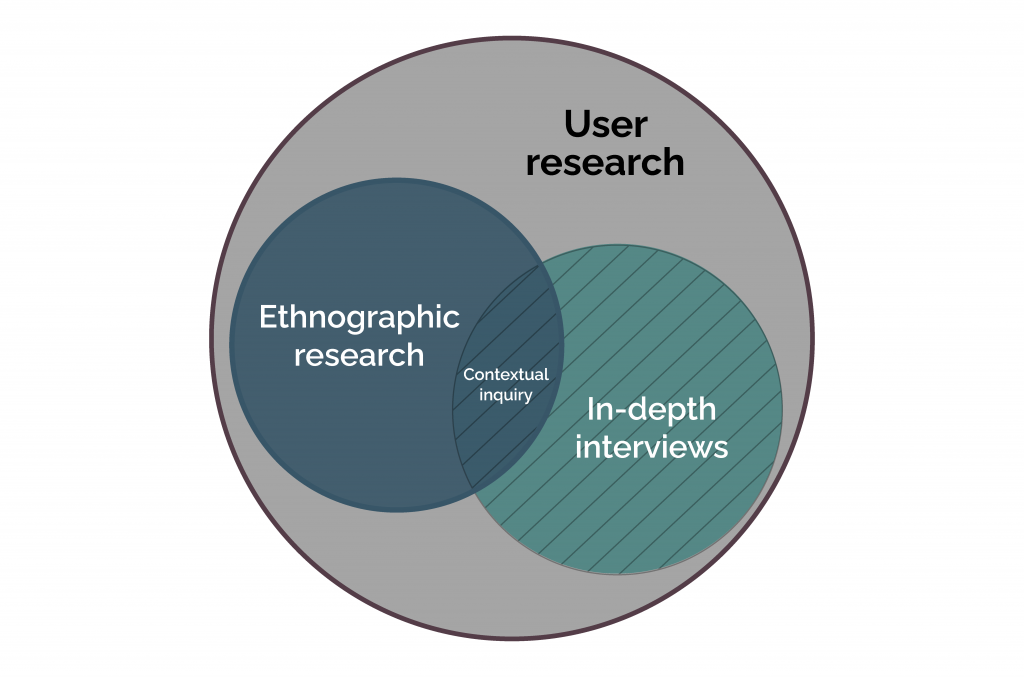While traditional approaches to user experience (UX) and customer experience (CX) research prioritize being present in the same location as the respondent, there are situations where in-person research is not feasible, such as during a global pandemic. Ethnography is a powerful, in-depth research method to capture rich insights about the human experience, including experience as a customer or tech user. Ethnographers traditionally collect data in person, often over extended periods. As with other UX research (UXR) methods, modern life challenges have accelerated virtual modalities in ethnography. It is essential to understand a bit about this methodology’s historical context to understand both the power of ethnography to generate useful insight and the challenges of employing it in a business setting. The rest of this article covers ethnography’s historical background in academic research, traditional adaptations of ethnography to business settings, and the challenges and benefits of digital transformations of ethnographic methods.
A Very Brief History of Ethnography
Though many people use the word ethnography to describe research methods, a traditional ethnography is a research product; it is a story or set of stories about a culture or community produced through various research methods. What makes ethnographies distinct from other types of research reports is that they are so rich in narrative that good ones read almost like a short story or novella rather than a typical research report. In one of the first ethnographies, Argonauts of the Western Pacific, Malinowski interweaves thorough scientific descriptions of culture in the Trobriand Islands with engaging stories of community members’ trade journeys. Keith Basso uses short morality tales from the Apache community to illustrate user accounts’ cultural traits to teach young people how to be good community members. In more recent years, social justice scholars such as Paul Farmer and Angela Stuesse have done applied ethnographies that addressed the overlap of economic hardship and poor health complementing statistical findings with engaging stories about community members.

The research methods used to produce an ethnography vary by project but usually include observation, semi-structured interviews, and experiential learning of a process. Observations are a vital tool for ethnography as they are for contextual inquiry. Detailed observation of a processor “day in the life” with video recording and a notetaker to augment recording capabilities provides a rich, first-hand understanding of an event or process. The key difference in using observation as a data collection method for ethnography versus contextual inquiry is that the former usually takes a broader context and lasts longer. In contrast, observations for contextual investigations are more focused on a specific workflow or process. Semi-structured interviews entail set questions with open-ended responses. This method focuses data collection on themes of interest to the researcher. Still, it allows the respondent to respond freely in their own words and not be bound to answer choices that may or may not be relevant to lived experience. Experiential learning complements these other methods by allowing the research to practice a task or different process under an expert’s tutelage. For any of these methods, good notetaking (preferably by a second researcher), video, recording, or both is essential to create detailed summaries of workflows, events, processes, or other phenomena for later qualitative analysis.
 Enter Business Ethnography
Enter Business Ethnography
The early ethnography applications for academic, social science and public benefit research may make this approach seem ill-suited to business research. Ethnography has been successfully used to address a broad array of business problems, including business strategy, organizational development and change, market research, and discovery research in UXR and CXR. Andrea Simon has used ethnographic methods to drive innovative “blue ocean” strategies for businesses in various sectors such as construction, healthcare, and government. Elisabeth Briody has used ethnographic methods to drive organizational development and transformation for several clients, including General Motors. ReD Associates is well-known for deep-dive ethnographic research that helps clients tailor marketing efforts to their customers. Sam Ladner pioneered using ethnography adapted for UXR to drive excellent product design and research strategy in high-value tech companies such as Microsoft, Amazon, and Workday. These are just a few examples of social scientists who have successfully adapted traditional ethnographic methods to solving business problems. While the conventional wisdom on business ethnography says that data collection is best done in person, there is a growing body of ethnography collected in digital spaces and focused on the digital world.

Digital Ethnography
Digital ethnography is a broad methodological umbrella that encompasses both video links between researcher and respondent(s) in real-time and asynchronous data collection from platforms and websites. Significant forms of digital ethnography include cultural probes, virtual tours, and netnography. Each form has its limitations, but these modes of doing ethnography also represent powerful innovations in UXR, particularly during a global pandemic or other situation that makes in-person data collection unfeasible. Digital ethnographic methods are beneficial for discovery or exploratory research for a deep dive into what users or customers need before or at the design process’s outset.
Cultural Probes
Cultural probes, also known as diary studies, involve the respondent’s data collection as they go about daily work activities. The researcher then reads, codes, and analyzes these data for patterns relevant to the product design or other business project in which the researcher is engaged. The mode of data collection for cultural probes is flexible. The respondent may write down reflections, collect artifacts from their activities (e.g., a document, email, lunch menu), or take photographs (these can be device agnostic, camera, phone, or tablet are proper photography tools this case). Once the respondent finishes data collection over the agreed time, the research team then reads or views the pieces of data and looks for patterns. Once a couple of team members have coded the data, and the team has built a consensus on coding divergences, the research team can have confidence in the themes that emerge from the diary entries, artifacts, or photos. This approach’s key benefit is that it makes it possible to glean a great deal of context about workflows and about other types of activities (e.g., lunch with colleagues) that may influence workflows or even what work is to be done. Because the respondent may not think of something that might be important to the business problem, it is good to use cultural probes in concert with another method like semi-structured interviews.

Virtual Tours
Another approach to virtual ethnography that relies heavily on visual data is the virtual tour. Cultural probes are driven by the respondent writing about or photographing processes over several days. A virtual tour is when the respondent shows the researcher(s) a work setting or process via a recorded video link. Virtual tours may be used for contextual inquiries as well as ethnographies. While specific virtual tour methods may vary and encompass methods such as the 3D walking tour or the 360º tour, the common thread is a respondent guiding the researcher or research team through a setting, workflow, process, or other events. With the combination of video recording in the real-time and conversational description from the respondent, virtual tours combine cultural probes’ visual data strengths with the respondent’s ability to provide context with words present in a semi-structured interview. Unlike a cultural probe, a virtual tour tends to be shorter in duration; a cultural probe may collect data off and on for several days, but a virtual tour tends to be capped at an hour or two. Due to the shorter duration, a virtual tour may not capture the day-to-day variation that a cultural probe or netnography would. It is best to either do a series of virtual tours of the same organization or combine virtual tours with other research methods to mitigate this shortcoming.
Netnography
Complementary to cultural probes and virtual tours with an active respondent is the virtual ethnographic method of netnography, which does not need an active respondent or asynchronous video tour or record. Netnography is an ethnographic method that focuses specifically on online interactions and communities. The researcher may collect data via chat interactions or arranged interviews with participants or by combing platform feeds and performing a careful analysis of the text and images to find themes and patterns. For instance, if a research team is trying to find out about a workflow or process, it might be useful to conduct a netnography of professional groups. Or interest groups on social media platforms such as Facebook, LinkedIn, or even Slack channels involve UXR for enterprise software.
In one case study of a UXR project I did for a previous startup client, I conducted a netnography to explore the market-need for a property-tech application purporting to help people build trust and relationships with their neighbors in dense urban areas. The management team wanted to launch the app within a month on a pilot site in Dubai’s target market. When this tight deadline was given to the research team, we had to rapidly adjust our research plan to eliminate the semi-structured interviews we were planning to do and focus on observations of Facebook interest groups that closely matched the target market. Gleaning insights from the Facebook group data involved doing a detailed reading, coding, and analysis of excerpts from the group feeds. We collected enough data in a few weeks to give reliable recommendations about the application’s key features even without interviews.
 Courtesy of https://racinemarcusbrown.crevado.com/
Courtesy of https://racinemarcusbrown.crevado.com/
As with the other digital ethnography approaches addressed in this article, it is not always possible to know what one is missing by doing just an observation-based netnography. The case study above involved samples from the feed, not the entire feed. Incorporating interviews into a netnography or using netnography in concert with other UXR methods such as contextual inquiry are ways to mitigate these deficiencies.
Challenges of Digital Ethnography
Regardless of the specific methods used, digital ethnography presents some common challenges relative to ethnographies that incorporate in-person data collection. Limited perspective and online communication friction are two critical challenges.
Limited perspective: For any of the three approaches described above, the researcher’s view is limited to what the respondent thinks is essential or chooses to show. An in-person observation session gives the researcher or research team much more latitude on observing and recording potentially crucial data for later analysis. It is difficult to know what is occurring off-camera, and therefore difficult to know if something important is being missed.
Online communication friction: As with the Zoom meetings with which so many have become familiar in the last year, remote data collection makes rapport building with a respondent harder and more awkward than it would be in-person. Interruptions, talk-overs, and technical difficulties happen in research sessions as they do in business meetings. Video conferencing and device fatigue may also be a problem for researchers and respondents alike.
Power of Digital Ethnography
Despite these challenges, digital ethnography is a powerful tool for UXR and other types of business research. The main benefits are cost, safety, and flexibility.
Cost: The most apparent benefit to doing digital UXR is cost. A business stands to save substantial amounts of time and money by researching the web compared to the travel, equipment, and supplies needed to research a person. This cost and time savings means that it is possible to research organizations or users via digital ethnography that it would not be feasible to do in-person.
Safety: Another significant benefit to digital ethnography and other digital forms of UXR is that they are safer and more feasible to do during the current COVID-19 pandemic or any future pandemic that dictates social distancing and remote work.
Flexibility: A more subtle benefit of digital ethnography is its flexibility to the respondent and the researcher. Data collection for a cultural probe can be accomplished over multiple days, focused on events the respondent thinks are most relevant, and done in a manner that fits the respondent’s schedule. A virtual tour requires synchronization between researcher and respondent but takes less logistical coordination and time than an in-person ethnographic data collection session. A netnography affords excellent flexibility to the researcher, as all or part of data collection may be asynchronous. Even a semi-structured interview may be accomplished via asynchronous questions and responses through a portal.
Wrapping Up
Though the traditional conventional wisdom holds that in-person data collection is superior in every way to virtual data collection, the current business reality has shown that digital ethnography can be a powerful tool in a UX researcher’s toolkit. The current crisis has spurred innovation and widespread adoption of digital ethnography to solve business problems.
Radiant Digital has strong digital ethnography expertise. We can uncover insights and transform business strategy, product lines, and more for any size or type of enterprise, from Fortune 500 companies to startups to government agencies.


